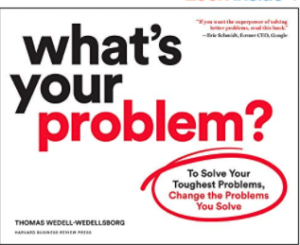 I had the good fortune recently to catch-up with Thomas Wedell-Wedellsborg, an international expert on problem-solving and innovation to discuss his new book, What’s Your Problem? To Solve Your Toughest Problems, Change the Problems You Solve.
I had the good fortune recently to catch-up with Thomas Wedell-Wedellsborg, an international expert on problem-solving and innovation to discuss his new book, What’s Your Problem? To Solve Your Toughest Problems, Change the Problems You Solve.
The book’s focus is on using reframing as a power-tool to examine the problem you are really trying to solve and to identify innovative solutions. I love the book for it’s powerful, practical guidance in an easy-to-read and apply format. Thomas was a delight to talk with and you’ll enjoy the interview and learn a great deal about reframing and problem-solving in the process. And, you’ll have a few laughs along the way!
What’s Your Problem? To Solve Your Toughest Problems, Change the Problems You Solve is one of my favorite recent works on thinking differently about the challenges we are navigating in this increasingly complex world. I particularly like this book as a resource for project, technical and other teams striving to solve market, competitive, and project challenges.
Enjoy the show and check out the highlights below!
![]()
[smart_track_player url=”https://artpetty.com/wp-content/uploads/2020/04/Thomas-Wedell-Wedellsborg-4_28_20-4.08-PM.mp3″ title=”Leadership Caffeine Podcast—Thomas Wedell-Wedellsborg on What’s Your Problem?”https://artpetty.com/wp-content/uploads/2011/07/Lcpodcast600x600.png” color=”#000000″ background=”#ffff00″ social_linkedin=”true” social_twitter=”true” social_facebook=”true” ]
Show Highlights:
Art asks Thomas “What problem are you trying to solve with this book?” and Thomas shares his view on the gap in our collective toolbox on solving problems. (1:00) “I’m trying to make the world better at problem-solving.”
Why Thomas is always a little disappointed when clients say, “This is great!” (2:00) Thomas: “Why aren’t we better at this?”
What happens when you try and teach reframing to 5,6, and 7 year-olds (4:25)
We need to “break the frame” and ask, What problem are we trying to solve? (5:30)
Thomas explains the Slow Elevator Problem as an example of reframing. “Sometimes the way to solve a problem is not to try and solve it, but is there a better problem to solve?” (6:00)
Breaking the frame is about stepping away from the initial problem framing. (7:45)
What happens when you present the Slow Elevator Problem to groups of fitness professionals (10:30)
Thomas comments on the phrase, “Beware of tools” as it relates to problem-solving (12:10)
Reframing is a way of thinking. (17:00)
The best way to improve at reframing is to practice on small problems (18:21)
Art and Thomas discuss helping the individual who has to deal with the difficult coworker. What’s the reframe here? (19:15)
The power of looking for bright spots and the notion of looking in the mirror (20:30)
How to teach a team how to use reframing (26:00)
Blending Six Thinking Hats (Edward de Bono) with reframing as part of problem-solving and some challenges in using creative approaches in some settings (28:00)
Get the facilitator out of some of these discussions and just talk (31:00)
How different companies react to and choose to use reframing (31:45)
Thomas shares his favorite framing situations (35:50)
Some domestic applications of reframing and the most brilliant strategy for dealing with a difficult boss ever! (38:00)
The power of having a conversation about your problem with a perfect stranger (41:00)
What Thomas learned about writing this book (41:40)
—

